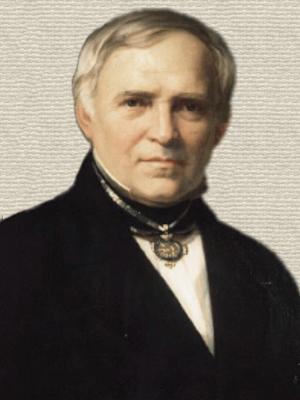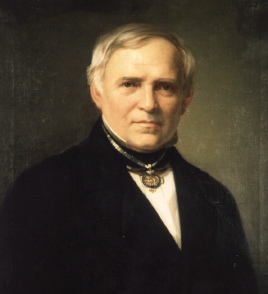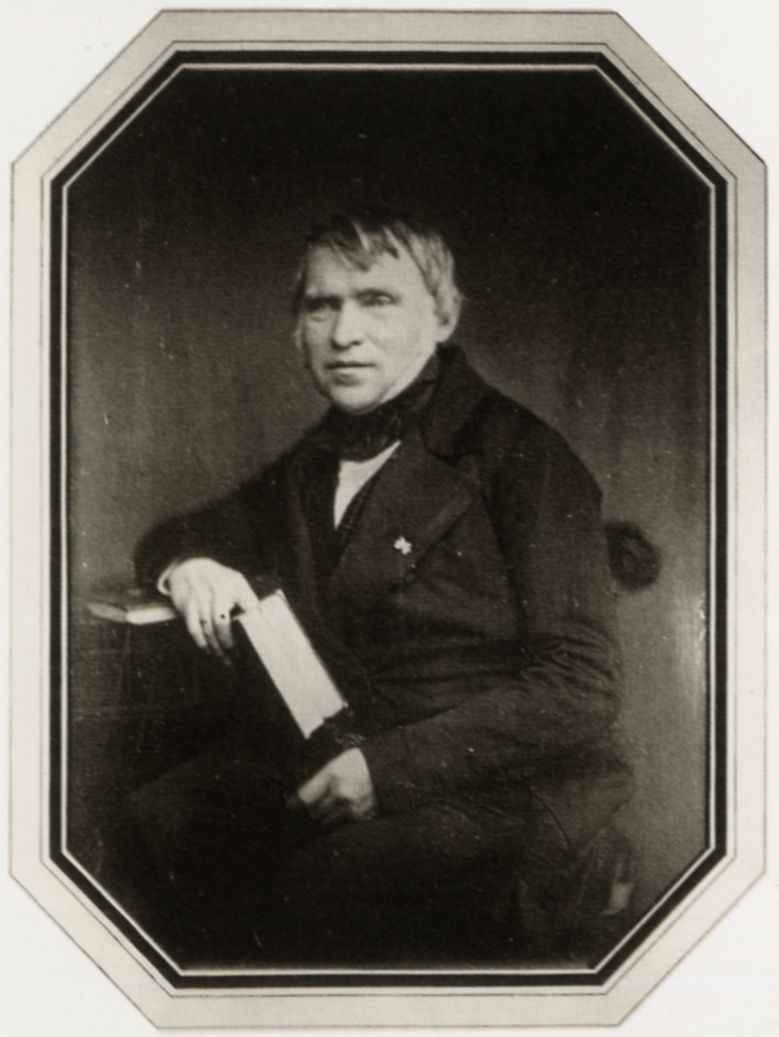Christian Gottfried Ehrenberg
Christian Gottfried Ehrenberg ( born April 19, 1795 in Delitzsch, † June 27, 1876 in Berlin) was a German zoologist, microbiologist, ecologist and geologist and one of the most famous and productive scientists of his time. Therefore, he was appointed to the Privy medical officer. He is the founder of micropaleontology and microbiology.
Life
Ehrenberg grew up as the son of Delitzsch citizen and Hospital superintendent Johann Gottfried Ehrenberg and visited the country Pforta. He studied theology in 1815 at the Theological Faculty of the University of Leipzig, then 1817/18 medicine and natural sciences. During this time he discovered the mold Syzygites. In 1818 he received his doctorate with a dissertation on fungi ( Sylvae mycologicae Berolinenses ) and became a member of the Leopoldina in Halle ( Saale). Then he made several smaller expeditions. He was a friend of Alexander von Humboldt.
From 1820 to 1825 he undertook together with Friedrich Wilhelm Hemprich an expedition to the Middle East and Arabia. Here they collected thousands of plant and animal species. They explored parts of Egypt, Palestine, the Libyan Desert, the Nile Valley and the northern coast of the Red Sea, where Ehrenberg dealt especially with corals. Another expedition 1825/26 led by Syria, the Arabian Peninsula and Abyssinia, where Hemprich died on 30 June 1825 fever. After his return Ehrenberg published a series of articles on insects and corals, as well as two volumes Symbolae physicae ( 1828-34 ) in which he described mammals, birds and insects scientifically.
In 1829 he accompanied Alexander von Humboldt and Gustav Rose on an expedition through Russia to the Urals and Siberia to the Altai, in which they advanced to the Chinese border. After returning from this expedition to Ehrenberg focused on micro- organisms, which were not systematically studied up to this point. During the next 30 years Ehrenberg examined countless water, rock and sediment samples indicate microorganisms. He used the microscopes of the Berlin optician Schieck, with whom he worked closely also. Every now and then the microscopes of Schieck were even called in professional circles Ehrenberg microscopes. Ehrenberg described thousands of new species, including such well-known today as the Euglena ( Euglena ) and the paramecium Paramecium caudatum and Paramecium aurelia.
His special interest was given to the individual learning. Unlike his opponent Félix Dujardin (1801-1860) went Ehrenberg mistakenly assume that the single-celled organisms have the same organs as the higher ( multicellular ) organisms. Felix Dujardin spoke here in 1835 from sarcodes a term later by the botanist Hugo von Mohl ( 1805-1872 ) with protoplasm, for the intracellular substance of the unicellular rhizopods was replaced.
He also proved that the phosphorescence is due to microorganisms. His studies microorganisms he continued until his death in Berlin. His grave is located on the St. Mary's and St. Nicholas Cemetery I in the Berlin district of Prenzlauer Berg.
He was married to Julie since 1831 and rose to his second wife in 1852 Friederike Karol.
Awards and legacy
Ehrenberg had since 1827 as an associate professor of medicine at the Friedrich- Wilhelms-Universität, now Humboldt University of Berlin, where he became on May 31, 1827 Member of the Royal Prussian Academy of Sciences in Berlin. He was also Foreign Fellow of the Royal Society and in 1839 was awarded the Wollaston Medal, the highest award of the Geological Society of London. This year, he also took his professorship as Professor of Medicine at the Friedrich- Wilhelms-Universität again. In 1842 he was elected secretary of the Physico- Mathematical Department of the Royal Prussian Academy of Sciences, a post which he held until 1867. In the same year he was elected to the Prussian Order Pour le Mérite for Sciences and Arts. In 1853 he was awarded the Bavarian Maximilian Order for Science and Art. Four times he was dean of his faculty and 1855/56 Rector of the Friedrich- Wilhelms-Universität. He was posthumously awarded in 1877 as the first, the Leeuwenhoek Medal.
The collection of his studies is now in the Museum of Natural History of the Humboldt University in Berlin. The " Ehrenberg Collection" includes 40,000 microscopic slides, 5,000 samples, 3,000 drawings and nearly 1,000 letters. The Ehrenberg in Berlin- Dahlem was the first address by Albert Einstein, after he had moved to Berlin.
Ehrenberg honor was named the High School in Delitzsch Christian Gottfried Ehrenberg High School. Also, one of Bastian Islands in the Hinlopen Strait ( Spitsbergen ) is named after Christian Gottfried Ehrenberg.
Worth mentioning
Ehrenberg had discovered and noticed the infusoria in Berlin, " that a large part of the land on which Berlin is, from these tiny hard-shelled creatures " is. In the city, many were worried because on many houses structural damage had occurred that would " crawl animals even with the houses it." Ehrenberg comforted: " do so carefully, gentlemen, that you do not understand why your house one morning stands on the Elbe ".
Works
- Building Bacillarien walls. In 1872.
- Talk in memory of Alexander von Humboldt. Oppenheim, Berlin, 1870.
- Commemorative speech held on 3 August 1856. Berlin 1856.
- On the position of the universities in the state. Berlin 1856.
- Micro geology. Voss, Leipzig 1854-56.
- About the dimensional stability and the development cycle of organic forms. Dümmler, Berlin, 1852.
- Passat dust and blood - rain. Berlin 1849.
- Communications on the red Passat dust and the consequent dark sea of Arabs. Reimer, Berlin, 1848.
- Speech to celebrate the anniversary of Leibnitz Leibnitz over method, relation to nature, research and correspondence with Leeuwenhoek. Voss, Leipzig, Berlin 1845.
- Dissemination and influence microscopic life in South and North America. Berlin 1843.
- About more numerous now living animal species of the Cretaceous formation. Berlin 1840.
- The formation of the European, Libyan and Arab chalk cliffs of chalk and marl of microscopic organisms. Berlin 1839.
- Microscopic analysis of the curländischen Meteor paper from 1686th Berlin 1839.
- Atlas on infusoria. Voss, Leipzig 1838.
- The infusoria as perfect organisms. Voss, Leipzig 1838.
- The fossil infusoria and the lively Dam Earth. Berlin 1837.
- Observation of a striking hitherto unrecognized structure of the psychic organ in humans and animals. Berlin 1836.
- Additions to the knowledge of large organizations in the small space. Berlin 1836.
- The glow of the sea.. Berlin 1835 ( co: Bernhard Wienker )
- Organization in the direction of the smallest space. Berlin 1834.
- To the knowledge of the organization in the direction of the smallest space. Dümmler, Berlin, 1832.
- Organization, systematics and geographical relations of the infusoria. Berlin 1830.
- Symbolae physicae. Berlin 1828-45. ( co: Friedrich Wilhelm and Johann Christoph Klug Hemprich )
- The geographical distribution of the infusoria in North Africa and West Asia. Berlin 1828th
- Natural History Travel through North Africa and West Asia in the years 1820-1825 by Dr. WF Hemprich and Dr. CG Ehrenberg, Historical part. Mediator, Berlin 1828th
- Contribution to Characteristik the deserts of North Africa. Too bad, Berlin 1827.
- Sylvae mycologicae Berolinensis. Bruschcke, Berlin 1818.










